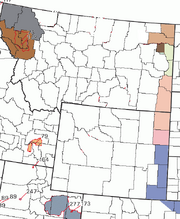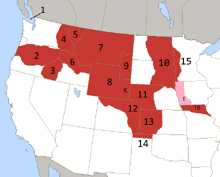Even though it is part of the 1983: Doomsday Timeline, its creator or creators have more work to do before it can be complete. You are welcome to give suggestions at the Talk Page. |
| |||||||
| Capital | Sydney | ||||||
| Largest city | Sydney | ||||||
| Other cities | Medicine Lake, New Castle | ||||||
| Language | English, Crow | ||||||
| Chairman | Cedric Black Eagle | ||||||
| Vice-Chairman | Coolidge Jefferson | ||||||
| Area | 26,480 mi | ||||||
| Population | approx. 26,000 (2010 est.) | ||||||
| Currency | Buffalo Dollar | ||||||
Absaroka is a state created by the Congress of the Provisional United States at the request of President Hunkins in 1993. Upon ratification by a vote of the inhabitants of the twelve counties affected, the Apsáaloose Free State became an autonomous state with full rights to representation in the government of the United States. Statehood was made official on September 22, 1994.
The capital of is Sydney. The estimated population is 26,000, of which 14,000 are of the Crow Nation. The government of the state, though republican, has an established dichotomy between the Crow and all non-Crow citizens. Though whites and other minorities have full rights, the tribal council is not open to anyone not of Crow blood. Exceptions are made if a citizen is adopted by the tribe. The present Chairman of the Council is Cedric Black Eagle.
History
The area that would become the state of Absaroka had been the home of American Indians for millennia, finally being the home of the Lakota and Dakota Indians in the time that it began to be hunted, then claimed and colonized, by the white man. The Dakota Territory was formed from parts of the Nebraska and Minnesota territories in 1861. By 1889, when it became the states of North and South Dakota, the territory had been reduced to roughly a rectangle diagonally divided by the Missouri River.
The area along the borders of the Dakotas ended up in the states of Montana, Wyoming, and a bit of Nebraska. The lands had been given to the Idaho and Wyoming territories in the 1860's. Throughout this period American Indian tribes had been fought and deported to various "reservations." Before this time, however, the Cheyenne tribe had occupied the "Powder River Country" in what was to become the US state of Montana. They had been forced there by the Lakota people over the course of their migration from the Great Lakes area. Other Cheyenne tribes were to settle in southeastern Montana and eastern Wyoming. These tribes, along with the Crow, would eventually sign peace treaties with the US government and move to reservations.
The Crow Tribe
more to come . . .
Doomsday
On September 25, 1983, the Crow tribe was as astonished as anyone when the bombs carpeted central Montana. Panic in nearby Billings had caused strained relationships between the Crow on the reservation and those in the city. However Chairman Donald Stewart soon had everything in control in Crow Agency. Before morning on the 26th, contact had been made with the Montana government as it set up emergency headquarters in Billings.
Absaroka
The purpose of the state was quite clear when the Crow Nation (at the time headquartered near Billings Montana) was offered a very generous incentive to move to the sparely populated border with the Republic of Lakota. When the Crow tribal leadership was told that they were to have authority in the twelve county area, stretched along the Montana and Wyoming borders with the Republic of Lakota, they saw a ten-fold increase in official territory. Other lesser tribes, such as the Cheyenne, were also incorporated into the new nation.
The Crow leadership put out a call to all Crow in the U.S. to come to "the border"

Absaroka on the right
where they could once more live "free." The other tribes also made similar calls. The population of the new state was then contacted, being offered the lands being vacated by the Crow, among other things, to relinquish the claim they had to the counties. The vote was not unanimous, of course, but it was substantially in favor of the change of government. Many of the people, especially from the cities, moved into the adjoining states, where jobs and land awaited them. Others remained, seeing the change as the political maneuver that it was, and continued life as usual.
| ||||||||||




